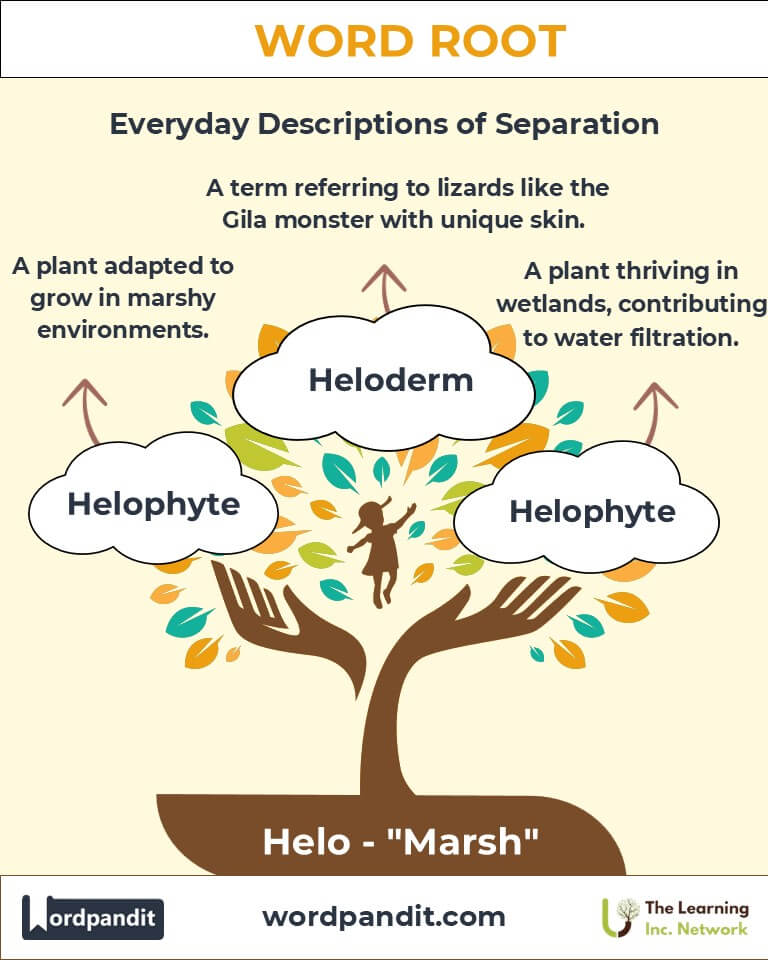Halo: The Salt Connection Across Science and Nature
Discover the fascinating journey of the word root "Halo," derived from the Greek "halos," meaning "salt." From the chemistry of halogens to the resilience of halophytes, "Halo" signifies the essence of salt and its pivotal role in both natural ecosystems and human innovation.

Table of Contents
- Introduction: The Salty Significance of "Halo"
- Etymology and Historical Journey
- Mnemonic: Unlocking the Power of "Halo"
- Common "Halo"-Related Terms
- "Halo" Through Time
- "Halo" in Specialized Fields
- Illustrative Story: "Halo" in Action
- Cultural Significance of "Halo"
- The "Halo" Family Tree
- FAQs about the Halo Word Root
- Test Your Knowledge: Halo Mastery Quiz
- Conclusion: The Legacy of "Halo"
Introduction: The Salty Significance of "Halo"
Have you ever marveled at the wonders of salt? The word root "Halo," pronounced "hay-loh," captures the multifaceted essence of salt, both in its natural abundance and scientific importance. Originating from the Greek "halos," meaning "salt," this root forms the basis of words that describe elements, ecosystems, and more. From halogens in chemistry to halophytes thriving in salty soils, "Halo" bridges the natural and scientific worlds.

Etymology and Historical Journey
The root "Halo" traces back to the Greek "halos," originally referring to salt or the sea. In ancient times, salt was revered as a precious commodity, earning the nickname "white gold." Over centuries, the term expanded beyond its culinary and preservative uses to become integral in scientific terminology. The 19th century witnessed the rise of "halogen," a term coined for elements that produce salts when combined with metals, marking "Halo's" deep integration into modern chemistry.
Mnemonic: Unlocking the Power of "Halo"
To remember "Halo," picture a glowing halo of salt crystals encircling a chemistry flask. This visualization ties the root to its meaning across science and nature.
Mnemonic Device: "Halo shines where salt defines—be it halogens, halophytes, or salty shores."
Common "Halo"-Related Terms
- Halogen (hay-loh-jen): Elements like fluorine, chlorine, and iodine that form salts when combined with metals.
Example: "Chlorine, a halogen, is essential for water purification." - Halophyte (hay-loh-fite): Plants adapted to thrive in salty environments.
Example: "Mangroves, a type of halophyte, play a vital role in coastal ecosystems." - Halite (hay-lite): Naturally occurring rock salt.
Example: "Halite deposits are mined for industrial and culinary uses." - Halocline (hay-lo-klin): A layer in water bodies where salinity changes sharply with depth.
Example: "Marine researchers study haloclines to understand ocean circulation." - Halochromic (hay-lo-kroh-mik): Substances that change color in response to changes in salt concentration or pH.
Example: "Halochromic dyes are used as indicators in chemical experiments."
"Halo" Through Time
- Halogen (19th Century): Coined from Greek "halos" (salt) and "gen" (producer), this term marked the identification of salt-forming elements in chemistry.
- Halophytes (20th Century): With the rise of ecology, "halophyte" described salt-tolerant plants, reflecting the growing interest in sustainable ecosystems.
"Halo" in Specialized Fields
- Chemistry:
Halogen: Vital in creating compounds like table salt (sodium chloride).
Application: Chlorine is used for water treatment and sanitation. - Ecology:
Halophyte: Plants like seagrasses help stabilize coastal areas.
Impact: These plants mitigate erosion and support biodiversity. - Oceanography:
Halocline: A critical factor in understanding ocean stratification and climate patterns.
Relevance: Haloclines influence global heat and nutrient distribution.
Illustrative Story: "Halo" in Action
In the coastal wetlands of Australia, a team of ecologists studied the halophyte Samphire, a plant that thrived despite high salinity. The researchers discovered that Samphire not only stabilized the soil but also absorbed excess salts, paving the way for innovative agricultural practices in saline environments. Meanwhile, a chemist in a nearby lab used halogen compounds to develop eco-friendly water purification systems. Together, they demonstrated how "Halo" connects diverse fields to address global challenges.
Cultural Significance of "Halo"
Salt, symbolized by "Halo," holds profound cultural and historical significance. Ancient civilizations valued salt for preservation and trade, while it played a role in religious rituals and superstitions. Expressions like “worth one's salt” highlight its importance in human history. Today, salt's dual identity—as a natural resource and scientific marvel—continues to shape our lives.

The "Halo" Family Tree
- Hal- (Salt):
Halophyte: Salt-loving plant.
Halite: Rock salt. - Sal- (Latin for Salt):
Saline: Containing salt.
Salinity: The concentration of salt in water. - Natron- (Ancient Egyptian for Sodium Carbonate):
Natrium: Latin term for sodium, used in modern chemistry.
FAQs About the "Halo" Word Root
Q: What does "Halo" mean?
A: "Halo" means "salt," derived from the Greek word "halos." Historically, salt was a valuable commodity used for preservation and trade, which highlights its enduring importance in various fields, including language, chemistry, and ecology.
Q: What is a halophyte?
A: A halophyte is a plant adapted to survive in environments with high salt concentrations, such as coastal marshes and salt flats. Examples include mangroves and Salicornia (glasswort). These plants play critical roles in stabilizing ecosystems and supporting biodiversity in saline habitats.
Q: What are halogens?
A: Halogens are a group of elements in the periodic table, including fluorine, chlorine, bromine, iodine, and astatine. They are highly reactive and form salts when combined with metals. For instance, sodium (a metal) and chlorine (a halogen) bond to create sodium chloride (table salt).
Q: What is halite?
A: Halite is the mineral form of sodium chloride, commonly known as rock salt. It is naturally found in deposits formed by the evaporation of ancient seas. Halite is extensively mined for use in food, industrial processes, and de-icing roads.
Q: How does "Halo" relate to chemistry?
A: The root "Halo" is central to terms like "halogen," describing elements that react with metals to form salts. It also appears in "halochromic," which refers to substances that change color based on salt concentration or pH, showcasing its significance in chemical reactions.
Q: What is a halocline?
A: A halocline is a layer in a body of water where there is a sharp change in salinity. For example, in oceans, fresh water from rivers can create a less salty layer above the denser, saltier seawater. Haloclines are important in studying ocean circulation, marine life, and climate systems.
Q: Why are halophytes important to the environment?
A: Halophytes help stabilize soils in salty environments, reduce erosion, and act as natural buffers against storms and rising sea levels. They also provide habitats for specialized flora and fauna, demonstrating their ecological significance.
Test Your Knowledge: "Halo" Mastery Quiz
1. What does the root "Halo" signify?
2. Which element is a halogen?
3. What is a halophyte?
4. What is halite commonly known as?
5. What does a halocline indicate?
Conclusion: The Legacy of "Halo"
The root "Halo" illuminates the indispensable role of salt in science, nature, and human history. From halogens driving chemical discoveries to halophytes sustaining delicate ecosystems, "Halo" showcases the profound connections between the natural world and scientific innovation. As we explore new frontiers, the salty essence of "Halo" will continue to inspire solutions and enrich our understanding of the world.












